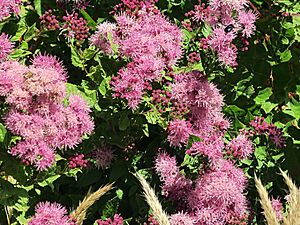Western snakeroot facts for kids
Quick facts for kids Western snakeroot |
|
|---|---|
 |
|
| Regional Parks Botanic Garden Berkeley, California |
|
| Scientific classification | |
| Synonyms | |
|
Ageratina occidentalis is a type of flowering plant in the daisy family. It is often called western snakeroot or western eupatorium. This plant grows naturally in the western United States. You can find it in many different places, like California, Oregon, Washington, Idaho, Montana, Nevada, and Utah.
Contents
What is Western Snakeroot?
Western snakeroot is a perennial herb. This means it lives for more than two years. It grows from underground stems called rhizomes. These stems help the plant spread.
The plant can grow up to 70 centimeters (about 27 inches) tall. Its stems can be green or purple. They are often covered in soft, tiny hairs.
Leaves and Flowers
The leaves of the western snakeroot are shaped like triangles. Their edges have small, sharp teeth, which is called being serrated. The leaves also have tiny glands. These glands might make the leaves feel a bit sticky.
The plant's flowers grow in tight groups. These groups are called inflorescences. Each group has many small flower heads. These flower heads are fuzzy. They contain long, thin flowers called disc florets. These florets can be white, pink, or blue. Unlike some other daisy-family plants, western snakeroot does not have ray florets (the petal-like parts you see on a daisy).
After the flowers bloom, the plant produces small fruits. Each fruit is called an achene. It is only a few millimeters long. The achene has a rough, bristly part called a pappus. This pappus helps the seeds float away in the wind.
What Do the Names Mean?
Plant names often have interesting meanings. The names of Ageratina occidentalis come from old languages.
The Name Ageratina
The first part of the plant's name, Ageratina, comes from Greek. It means 'un-aging'. This name was given because the flowers keep their color for a long time. An ancient Greek doctor named Dioscorides used this name for different plants.
The Name Eupatorium
The name Eupatorium comes from a Greek king. His name was Mithridates Eupator. People say that this king found out that a plant in this group could be used as a medicine. It was thought to be an antidote to a common poison.

